Workplace Safety and Health Report: Regulations and Compliance
VerifiedAdded on 2020/03/13
|8
|1332
|41
Report
AI Summary
This report provides a comprehensive overview of occupational health and safety (OHS) regulations and best practices within a workplace setting. It meticulously examines various aspects of workplace safety, including manual handling, transportation, loading goods, packing, and forklift operations. The report references key legislations such as the Work Health and Safety Act 2011, Environmental Biodiversity Conservation Act of 1999, and SafeWork Codes Australia, along with relevant codes of conduct and guidelines. The report addresses specific safety concerns, such as creating well-lit and dust-free environments, preventing injuries from heavy lifting, and ensuring proper equipment maintenance and operation. The report also addresses administrative work using computers and the implementation of safety measures for loading goods at docking areas. It emphasizes the importance of training, risk assessment, and the use of personal protective equipment to minimize workplace hazards and ensure employee safety. The report draws on various sources, including books and journal articles, to support its findings and recommendations.
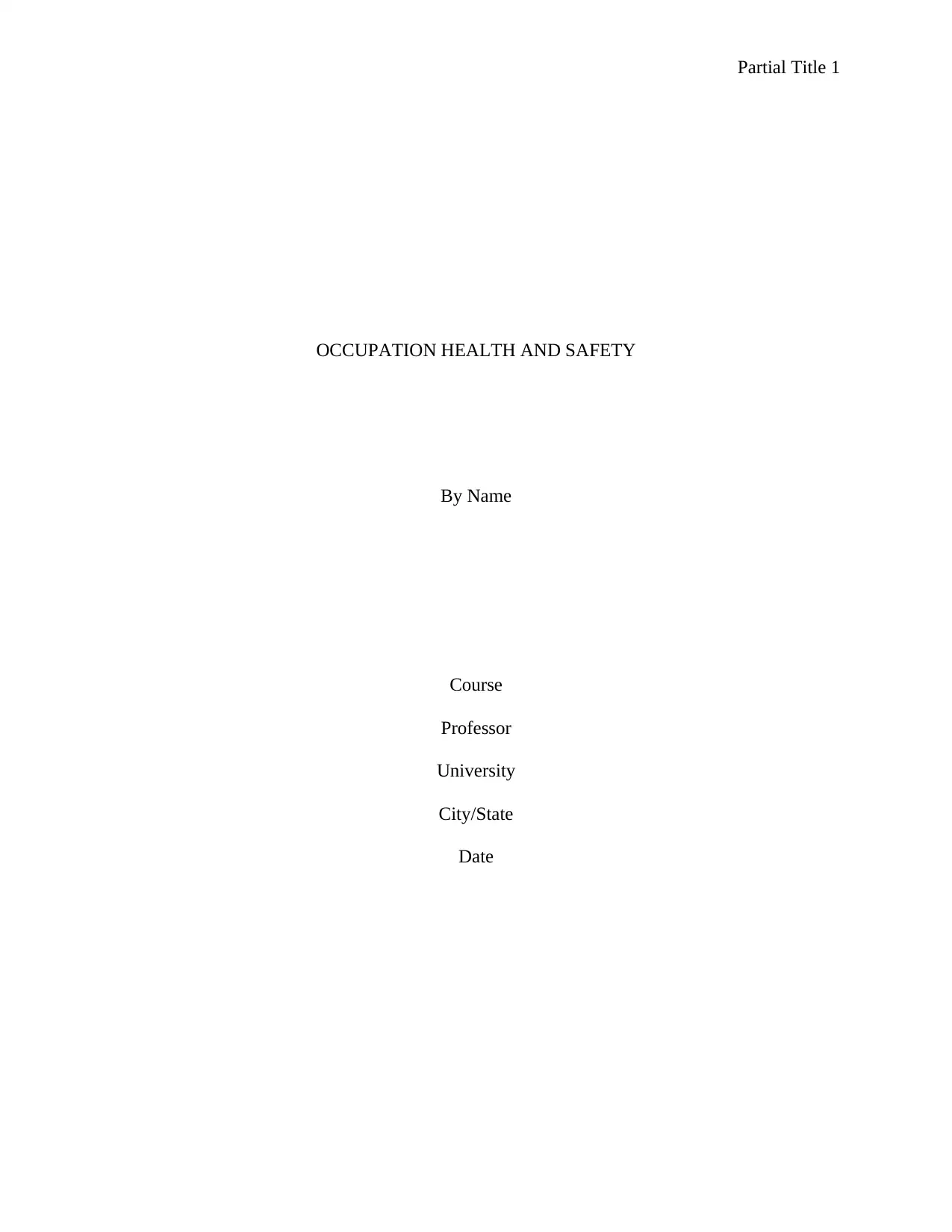
Partial Title 1
OCCUPATION HEALTH AND SAFETY
By Name
Course
Professor
University
City/State
Date
OCCUPATION HEALTH AND SAFETY
By Name
Course
Professor
University
City/State
Date
Paraphrase This Document
Need a fresh take? Get an instant paraphrase of this document with our AI Paraphraser
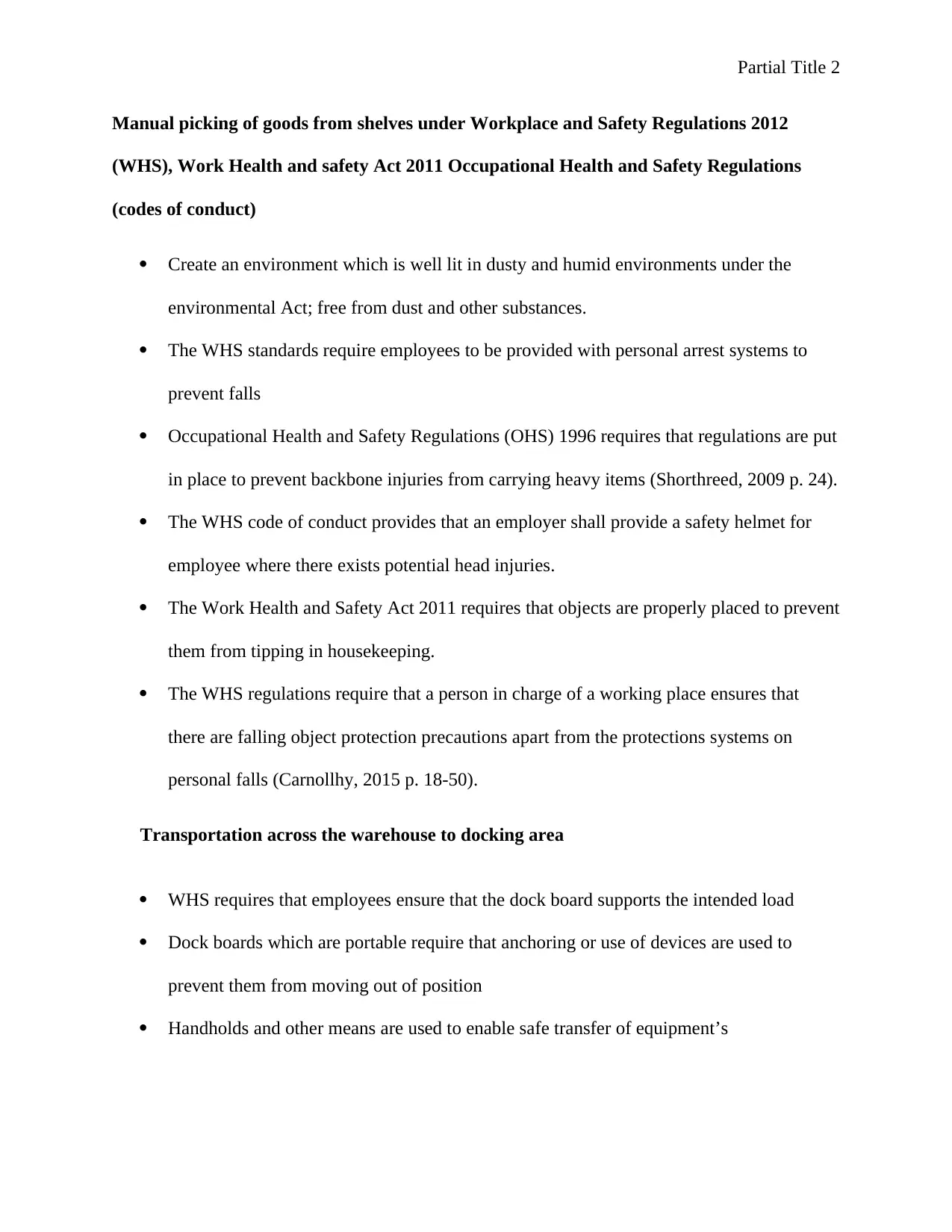
Partial Title 2
Manual picking of goods from shelves under Workplace and Safety Regulations 2012
(WHS), Work Health and safety Act 2011 Occupational Health and Safety Regulations
(codes of conduct)
Create an environment which is well lit in dusty and humid environments under the
environmental Act; free from dust and other substances.
The WHS standards require employees to be provided with personal arrest systems to
prevent falls
Occupational Health and Safety Regulations (OHS) 1996 requires that regulations are put
in place to prevent backbone injuries from carrying heavy items (Shorthreed, 2009 p. 24).
The WHS code of conduct provides that an employer shall provide a safety helmet for
employee where there exists potential head injuries.
The Work Health and Safety Act 2011 requires that objects are properly placed to prevent
them from tipping in housekeeping.
The WHS regulations require that a person in charge of a working place ensures that
there are falling object protection precautions apart from the protections systems on
personal falls (Carnollhy, 2015 p. 18-50).
Transportation across the warehouse to docking area
WHS requires that employees ensure that the dock board supports the intended load
Dock boards which are portable require that anchoring or use of devices are used to
prevent them from moving out of position
Handholds and other means are used to enable safe transfer of equipment’s
Manual picking of goods from shelves under Workplace and Safety Regulations 2012
(WHS), Work Health and safety Act 2011 Occupational Health and Safety Regulations
(codes of conduct)
Create an environment which is well lit in dusty and humid environments under the
environmental Act; free from dust and other substances.
The WHS standards require employees to be provided with personal arrest systems to
prevent falls
Occupational Health and Safety Regulations (OHS) 1996 requires that regulations are put
in place to prevent backbone injuries from carrying heavy items (Shorthreed, 2009 p. 24).
The WHS code of conduct provides that an employer shall provide a safety helmet for
employee where there exists potential head injuries.
The Work Health and Safety Act 2011 requires that objects are properly placed to prevent
them from tipping in housekeeping.
The WHS regulations require that a person in charge of a working place ensures that
there are falling object protection precautions apart from the protections systems on
personal falls (Carnollhy, 2015 p. 18-50).
Transportation across the warehouse to docking area
WHS requires that employees ensure that the dock board supports the intended load
Dock boards which are portable require that anchoring or use of devices are used to
prevent them from moving out of position
Handholds and other means are used to enable safe transfer of equipment’s
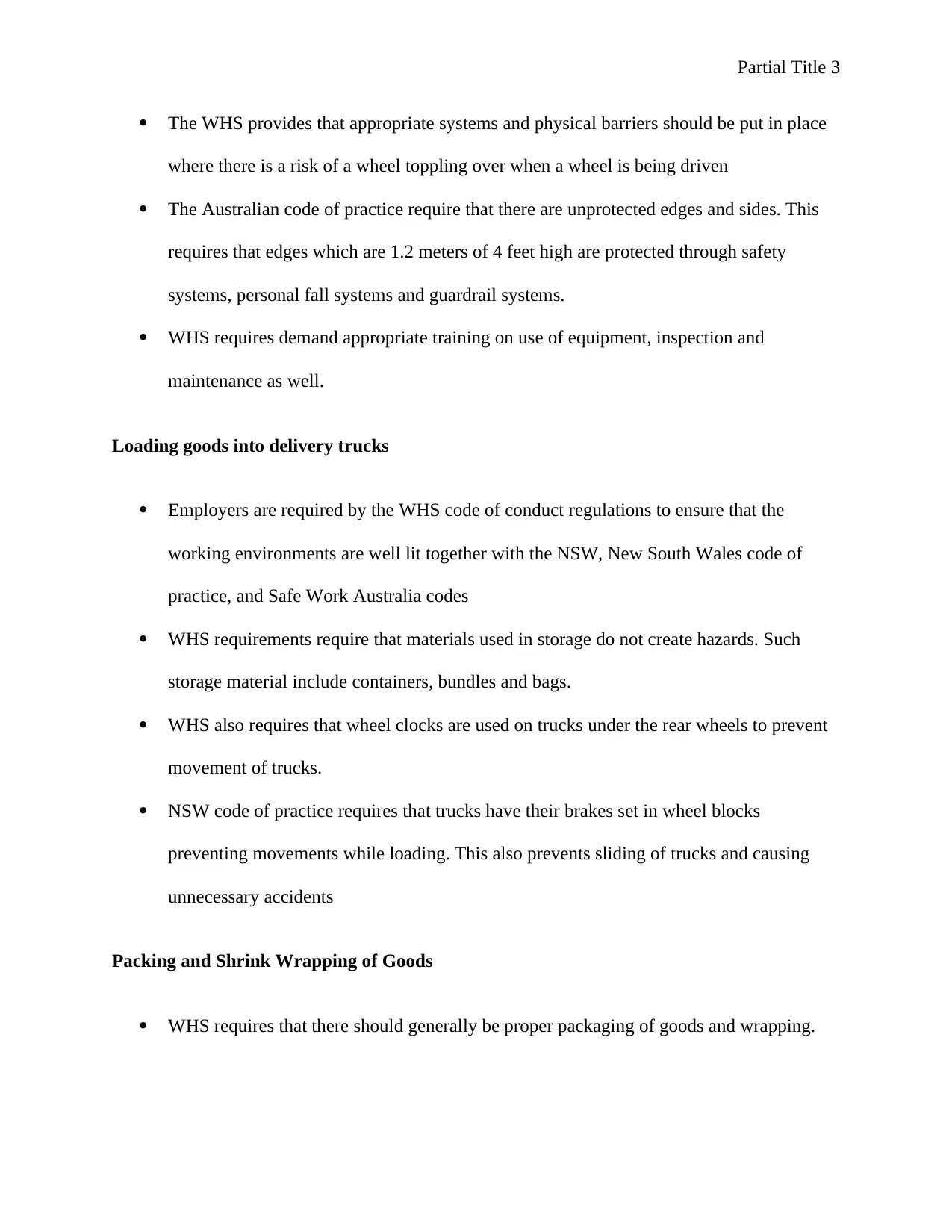
Partial Title 3
The WHS provides that appropriate systems and physical barriers should be put in place
where there is a risk of a wheel toppling over when a wheel is being driven
The Australian code of practice require that there are unprotected edges and sides. This
requires that edges which are 1.2 meters of 4 feet high are protected through safety
systems, personal fall systems and guardrail systems.
WHS requires demand appropriate training on use of equipment, inspection and
maintenance as well.
Loading goods into delivery trucks
Employers are required by the WHS code of conduct regulations to ensure that the
working environments are well lit together with the NSW, New South Wales code of
practice, and Safe Work Australia codes
WHS requirements require that materials used in storage do not create hazards. Such
storage material include containers, bundles and bags.
WHS also requires that wheel clocks are used on trucks under the rear wheels to prevent
movement of trucks.
NSW code of practice requires that trucks have their brakes set in wheel blocks
preventing movements while loading. This also prevents sliding of trucks and causing
unnecessary accidents
Packing and Shrink Wrapping of Goods
WHS requires that there should generally be proper packaging of goods and wrapping.
The WHS provides that appropriate systems and physical barriers should be put in place
where there is a risk of a wheel toppling over when a wheel is being driven
The Australian code of practice require that there are unprotected edges and sides. This
requires that edges which are 1.2 meters of 4 feet high are protected through safety
systems, personal fall systems and guardrail systems.
WHS requires demand appropriate training on use of equipment, inspection and
maintenance as well.
Loading goods into delivery trucks
Employers are required by the WHS code of conduct regulations to ensure that the
working environments are well lit together with the NSW, New South Wales code of
practice, and Safe Work Australia codes
WHS requirements require that materials used in storage do not create hazards. Such
storage material include containers, bundles and bags.
WHS also requires that wheel clocks are used on trucks under the rear wheels to prevent
movement of trucks.
NSW code of practice requires that trucks have their brakes set in wheel blocks
preventing movements while loading. This also prevents sliding of trucks and causing
unnecessary accidents
Packing and Shrink Wrapping of Goods
WHS requires that there should generally be proper packaging of goods and wrapping.
⊘ This is a preview!⊘
Do you want full access?
Subscribe today to unlock all pages.

Trusted by 1+ million students worldwide
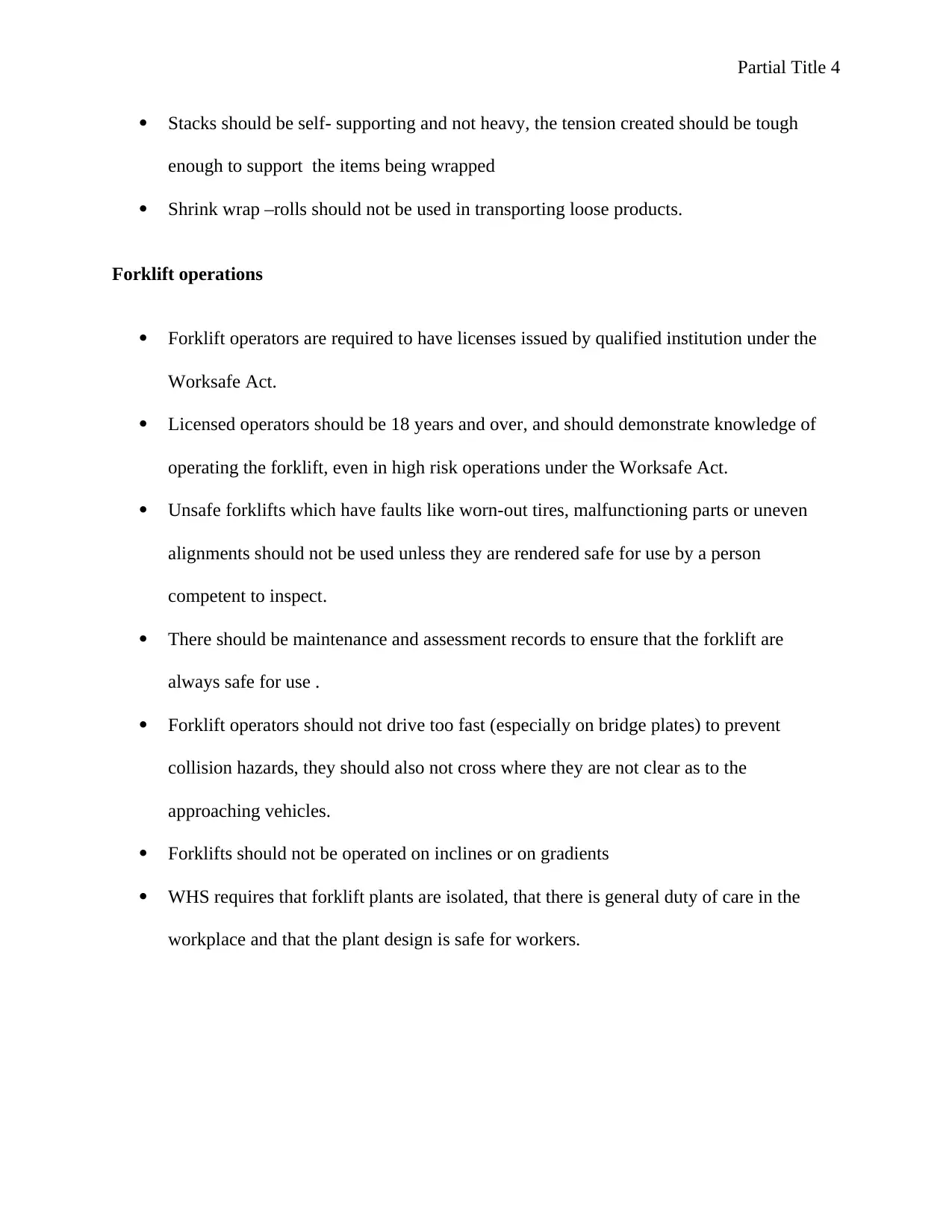
Partial Title 4
Stacks should be self- supporting and not heavy, the tension created should be tough
enough to support the items being wrapped
Shrink wrap –rolls should not be used in transporting loose products.
Forklift operations
Forklift operators are required to have licenses issued by qualified institution under the
Worksafe Act.
Licensed operators should be 18 years and over, and should demonstrate knowledge of
operating the forklift, even in high risk operations under the Worksafe Act.
Unsafe forklifts which have faults like worn-out tires, malfunctioning parts or uneven
alignments should not be used unless they are rendered safe for use by a person
competent to inspect.
There should be maintenance and assessment records to ensure that the forklift are
always safe for use .
Forklift operators should not drive too fast (especially on bridge plates) to prevent
collision hazards, they should also not cross where they are not clear as to the
approaching vehicles.
Forklifts should not be operated on inclines or on gradients
WHS requires that forklift plants are isolated, that there is general duty of care in the
workplace and that the plant design is safe for workers.
Stacks should be self- supporting and not heavy, the tension created should be tough
enough to support the items being wrapped
Shrink wrap –rolls should not be used in transporting loose products.
Forklift operations
Forklift operators are required to have licenses issued by qualified institution under the
Worksafe Act.
Licensed operators should be 18 years and over, and should demonstrate knowledge of
operating the forklift, even in high risk operations under the Worksafe Act.
Unsafe forklifts which have faults like worn-out tires, malfunctioning parts or uneven
alignments should not be used unless they are rendered safe for use by a person
competent to inspect.
There should be maintenance and assessment records to ensure that the forklift are
always safe for use .
Forklift operators should not drive too fast (especially on bridge plates) to prevent
collision hazards, they should also not cross where they are not clear as to the
approaching vehicles.
Forklifts should not be operated on inclines or on gradients
WHS requires that forklift plants are isolated, that there is general duty of care in the
workplace and that the plant design is safe for workers.
Paraphrase This Document
Need a fresh take? Get an instant paraphrase of this document with our AI Paraphraser
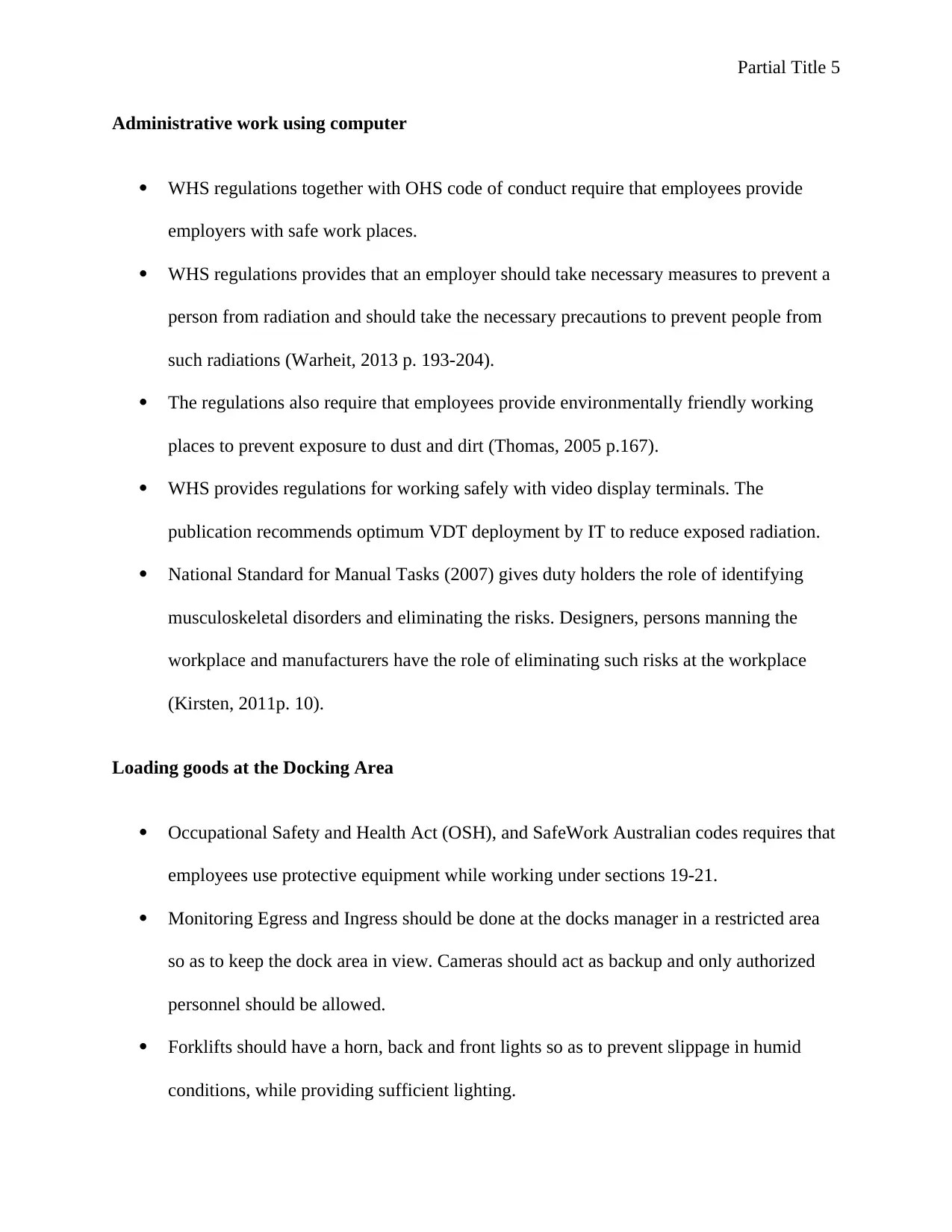
Partial Title 5
Administrative work using computer
WHS regulations together with OHS code of conduct require that employees provide
employers with safe work places.
WHS regulations provides that an employer should take necessary measures to prevent a
person from radiation and should take the necessary precautions to prevent people from
such radiations (Warheit, 2013 p. 193-204).
The regulations also require that employees provide environmentally friendly working
places to prevent exposure to dust and dirt (Thomas, 2005 p.167).
WHS provides regulations for working safely with video display terminals. The
publication recommends optimum VDT deployment by IT to reduce exposed radiation.
National Standard for Manual Tasks (2007) gives duty holders the role of identifying
musculoskeletal disorders and eliminating the risks. Designers, persons manning the
workplace and manufacturers have the role of eliminating such risks at the workplace
(Kirsten, 2011p. 10).
Loading goods at the Docking Area
Occupational Safety and Health Act (OSH), and SafeWork Australian codes requires that
employees use protective equipment while working under sections 19-21.
Monitoring Egress and Ingress should be done at the docks manager in a restricted area
so as to keep the dock area in view. Cameras should act as backup and only authorized
personnel should be allowed.
Forklifts should have a horn, back and front lights so as to prevent slippage in humid
conditions, while providing sufficient lighting.
Administrative work using computer
WHS regulations together with OHS code of conduct require that employees provide
employers with safe work places.
WHS regulations provides that an employer should take necessary measures to prevent a
person from radiation and should take the necessary precautions to prevent people from
such radiations (Warheit, 2013 p. 193-204).
The regulations also require that employees provide environmentally friendly working
places to prevent exposure to dust and dirt (Thomas, 2005 p.167).
WHS provides regulations for working safely with video display terminals. The
publication recommends optimum VDT deployment by IT to reduce exposed radiation.
National Standard for Manual Tasks (2007) gives duty holders the role of identifying
musculoskeletal disorders and eliminating the risks. Designers, persons manning the
workplace and manufacturers have the role of eliminating such risks at the workplace
(Kirsten, 2011p. 10).
Loading goods at the Docking Area
Occupational Safety and Health Act (OSH), and SafeWork Australian codes requires that
employees use protective equipment while working under sections 19-21.
Monitoring Egress and Ingress should be done at the docks manager in a restricted area
so as to keep the dock area in view. Cameras should act as backup and only authorized
personnel should be allowed.
Forklifts should have a horn, back and front lights so as to prevent slippage in humid
conditions, while providing sufficient lighting.
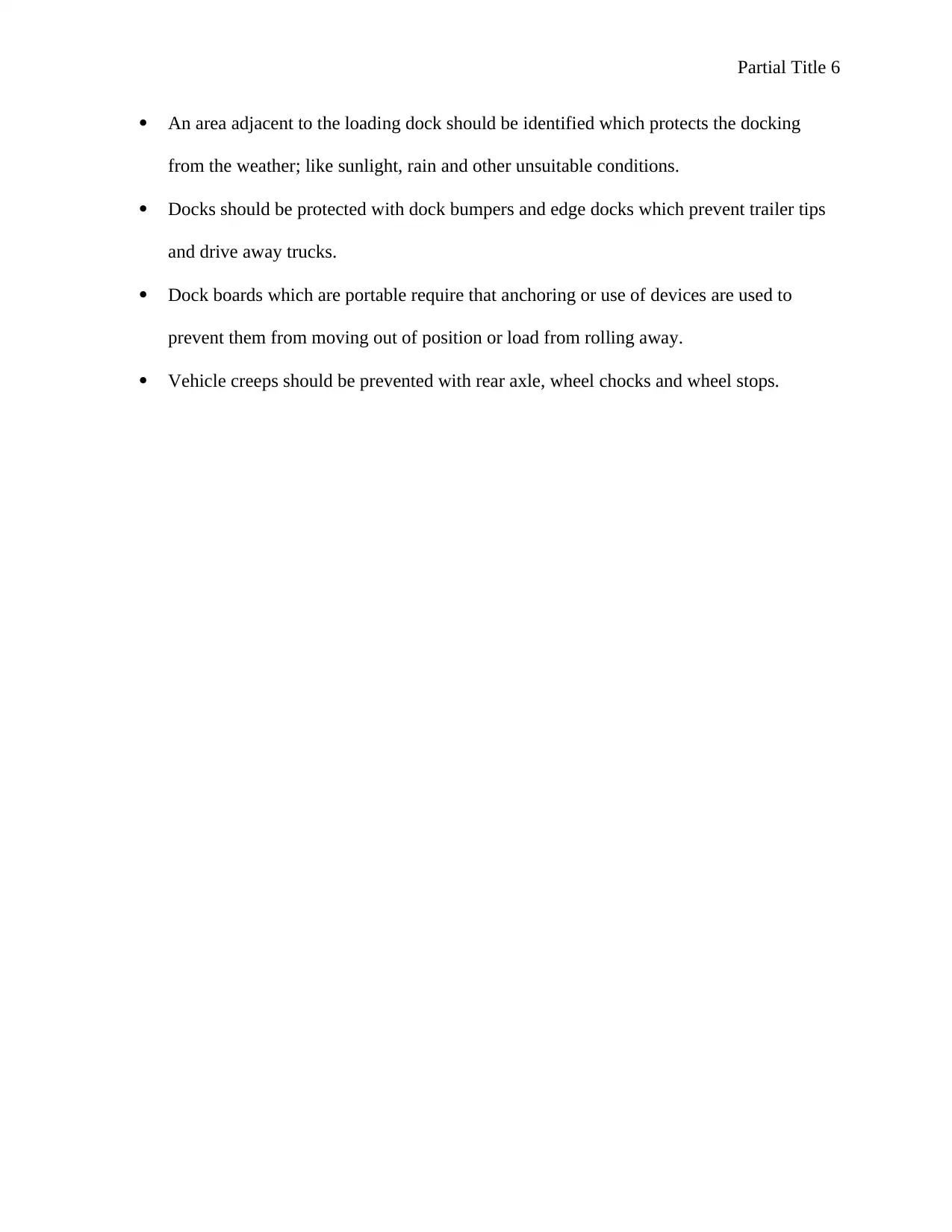
Partial Title 6
An area adjacent to the loading dock should be identified which protects the docking
from the weather; like sunlight, rain and other unsuitable conditions.
Docks should be protected with dock bumpers and edge docks which prevent trailer tips
and drive away trucks.
Dock boards which are portable require that anchoring or use of devices are used to
prevent them from moving out of position or load from rolling away.
Vehicle creeps should be prevented with rear axle, wheel chocks and wheel stops.
An area adjacent to the loading dock should be identified which protects the docking
from the weather; like sunlight, rain and other unsuitable conditions.
Docks should be protected with dock bumpers and edge docks which prevent trailer tips
and drive away trucks.
Dock boards which are portable require that anchoring or use of devices are used to
prevent them from moving out of position or load from rolling away.
Vehicle creeps should be prevented with rear axle, wheel chocks and wheel stops.
⊘ This is a preview!⊘
Do you want full access?
Subscribe today to unlock all pages.

Trusted by 1+ million students worldwide
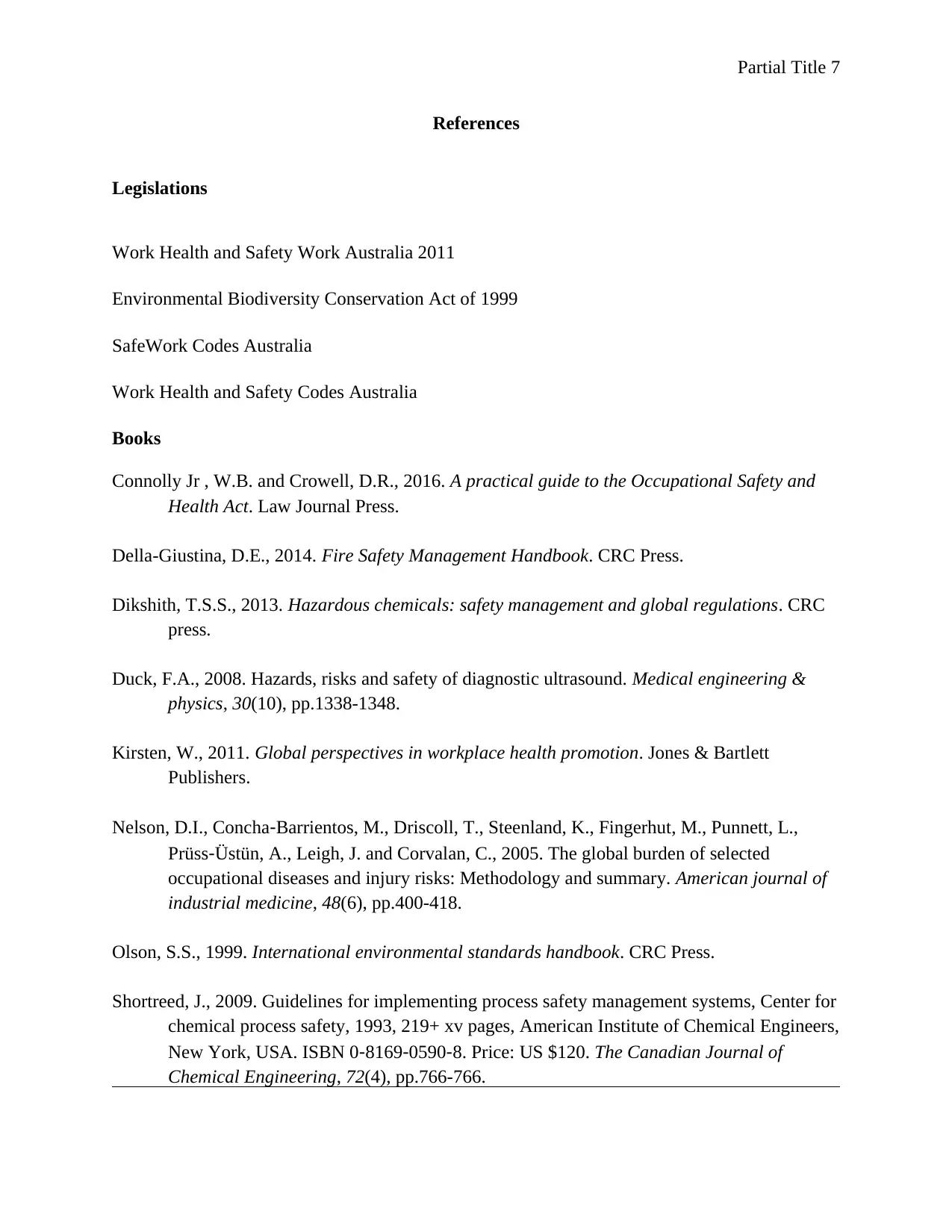
Partial Title 7
References
Legislations
Work Health and Safety Work Australia 2011
Environmental Biodiversity Conservation Act of 1999
SafeWork Codes Australia
Work Health and Safety Codes Australia
Books
Connolly Jr , W.B. and Crowell, D.R., 2016. A practical guide to the Occupational Safety and
Health Act. Law Journal Press.
Della-Giustina, D.E., 2014. Fire Safety Management Handbook. CRC Press.
Dikshith, T.S.S., 2013. Hazardous chemicals: safety management and global regulations. CRC
press.
Duck, F.A., 2008. Hazards, risks and safety of diagnostic ultrasound. Medical engineering &
physics, 30(10), pp.1338-1348.
Kirsten, W., 2011. Global perspectives in workplace health promotion. Jones & Bartlett
Publishers.
Nelson, D.I., Concha‐Barrientos, M., Driscoll, T., Steenland, K., Fingerhut, M., Punnett, L.,
Prüss‐Üstün, A., Leigh, J. and Corvalan, C., 2005. The global burden of selected
occupational diseases and injury risks: Methodology and summary. American journal of
industrial medicine, 48(6), pp.400-418.
Olson, S.S., 1999. International environmental standards handbook. CRC Press.
Shortreed, J., 2009. Guidelines for implementing process safety management systems, Center for
chemical process safety, 1993, 219+ xv pages, American Institute of Chemical Engineers,
New York, USA. ISBN 0‐8169‐0590‐8. Price: US $120. The Canadian Journal of
Chemical Engineering, 72(4), pp.766-766.
References
Legislations
Work Health and Safety Work Australia 2011
Environmental Biodiversity Conservation Act of 1999
SafeWork Codes Australia
Work Health and Safety Codes Australia
Books
Connolly Jr , W.B. and Crowell, D.R., 2016. A practical guide to the Occupational Safety and
Health Act. Law Journal Press.
Della-Giustina, D.E., 2014. Fire Safety Management Handbook. CRC Press.
Dikshith, T.S.S., 2013. Hazardous chemicals: safety management and global regulations. CRC
press.
Duck, F.A., 2008. Hazards, risks and safety of diagnostic ultrasound. Medical engineering &
physics, 30(10), pp.1338-1348.
Kirsten, W., 2011. Global perspectives in workplace health promotion. Jones & Bartlett
Publishers.
Nelson, D.I., Concha‐Barrientos, M., Driscoll, T., Steenland, K., Fingerhut, M., Punnett, L.,
Prüss‐Üstün, A., Leigh, J. and Corvalan, C., 2005. The global burden of selected
occupational diseases and injury risks: Methodology and summary. American journal of
industrial medicine, 48(6), pp.400-418.
Olson, S.S., 1999. International environmental standards handbook. CRC Press.
Shortreed, J., 2009. Guidelines for implementing process safety management systems, Center for
chemical process safety, 1993, 219+ xv pages, American Institute of Chemical Engineers,
New York, USA. ISBN 0‐8169‐0590‐8. Price: US $120. The Canadian Journal of
Chemical Engineering, 72(4), pp.766-766.
Paraphrase This Document
Need a fresh take? Get an instant paraphrase of this document with our AI Paraphraser
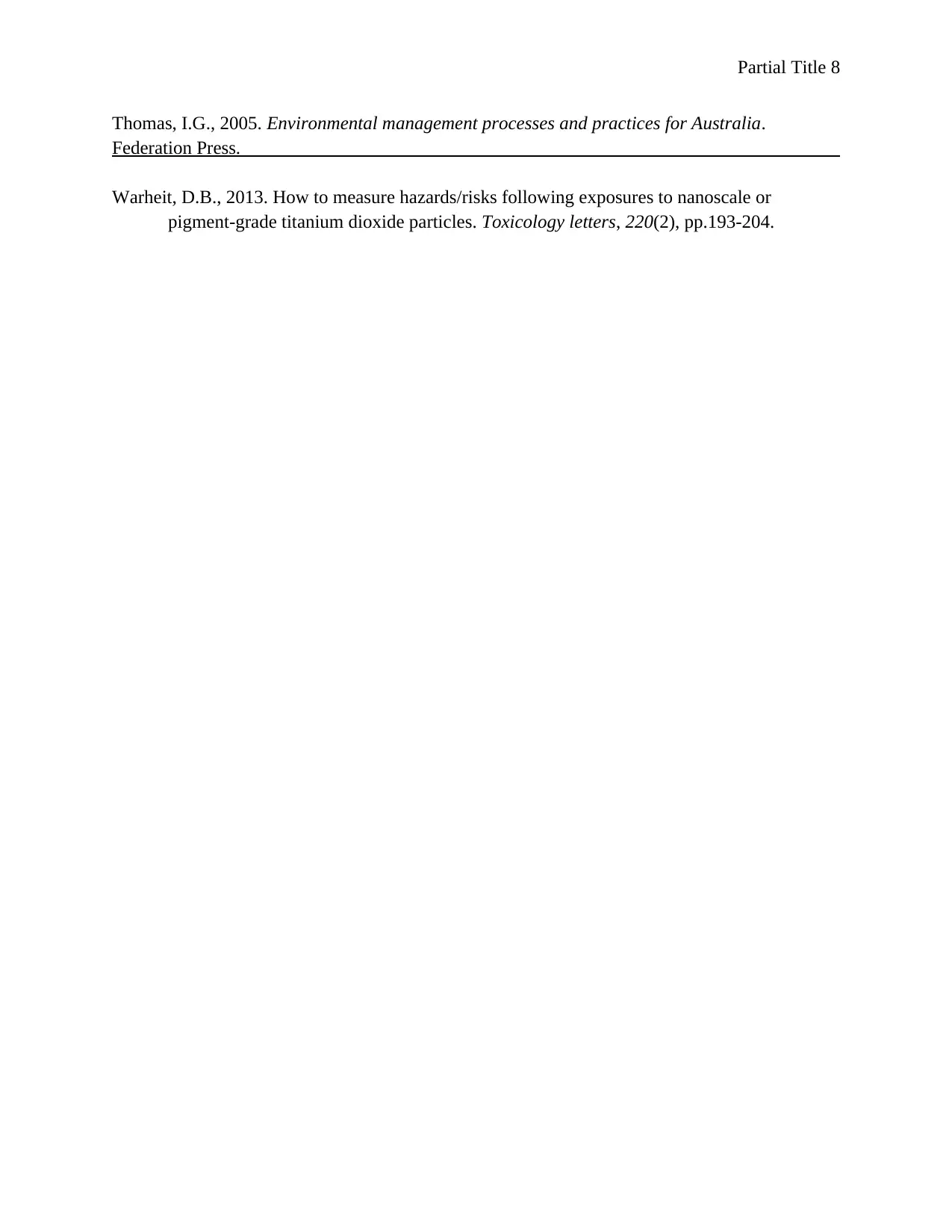
Partial Title 8
Thomas, I.G., 2005. Environmental management processes and practices for Australia.
Federation Press.
Warheit, D.B., 2013. How to measure hazards/risks following exposures to nanoscale or
pigment-grade titanium dioxide particles. Toxicology letters, 220(2), pp.193-204.
Thomas, I.G., 2005. Environmental management processes and practices for Australia.
Federation Press.
Warheit, D.B., 2013. How to measure hazards/risks following exposures to nanoscale or
pigment-grade titanium dioxide particles. Toxicology letters, 220(2), pp.193-204.
1 out of 8
Related Documents
Your All-in-One AI-Powered Toolkit for Academic Success.
+13062052269
info@desklib.com
Available 24*7 on WhatsApp / Email
![[object Object]](/_next/static/media/star-bottom.7253800d.svg)
Unlock your academic potential
Copyright © 2020–2025 A2Z Services. All Rights Reserved. Developed and managed by ZUCOL.




